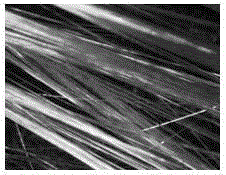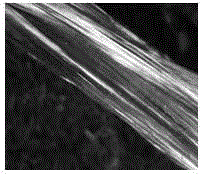Method for preparing ultrafine carbon fiber bundles reinforced by aldehyde resins
An ultra-fine carbon fiber and resin technology, which is applied in chemical instruments and methods, synthetic resin layered products, lamination devices, etc., can solve the problems such as the incompetence of metal wire mesh and metal sintered felt, achieve high practical value, and is conducive to Emission reduction effect
- Summary
- Abstract
- Description
- Claims
- Application Information
AI Technical Summary
Problems solved by technology
Method used
Image
Examples
Embodiment 1
[0022] like figure 2 As shown, select 10 parts of industrial phenolic resin, add 89 parts of industrial alcohol as a solvent, add 5 parts of triethanolamine as a softener, stir and dissolve to form a binder liquid; use commercially available 1K carbon fiber bundles, soak this as a The binder is then purged with 100Kpa compressed air to remove excess binder; placed at room temperature at about 25°C for 4 hours, then moved into an oven with a temperature of 120°C, and the fiber bundles are cured for 5 hours.
Embodiment 2
[0024] Select 15 parts of industrial phenolic resin, add 78 parts of industrial alcohol as a solvent, add 7 parts of triethanolamine as a softener, stir and dissolve to form a binder liquid; use commercially available 1K carbon fiber bundles, soak this as a binder , and then use 100Kpa compressed air to purge to remove excess binder; at room temperature about 25°C, place for 5h, then move into an oven with a temperature of 130°C, and cure the fiber bundles for 4h.
Embodiment 3
[0026] Select 20 parts of industrial phenolic resin, add 75 parts of industrial alcohol as a solvent, add 8 parts of triethanolamine as a softener, stir and dissolve to form a binder liquid; use commercially available 1K carbon fiber bundles, soak this as a binder , and then use 100Kpa compressed air to purge to remove excess binder; place at room temperature about 25°C for 5h, then move it into an oven with a temperature of 140°C, and cure the fiber bundles for 3h.
PUM
| Property | Measurement | Unit |
|---|---|---|
| particle size | aaaaa | aaaaa |
| tensile strength | aaaaa | aaaaa |
Abstract
Description
Claims
Application Information
 Login to View More
Login to View More - R&D
- Intellectual Property
- Life Sciences
- Materials
- Tech Scout
- Unparalleled Data Quality
- Higher Quality Content
- 60% Fewer Hallucinations
Browse by: Latest US Patents, China's latest patents, Technical Efficacy Thesaurus, Application Domain, Technology Topic, Popular Technical Reports.
© 2025 PatSnap. All rights reserved.Legal|Privacy policy|Modern Slavery Act Transparency Statement|Sitemap|About US| Contact US: help@patsnap.com


